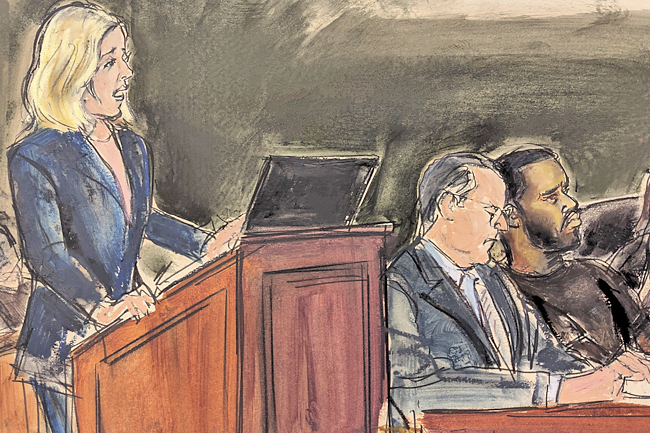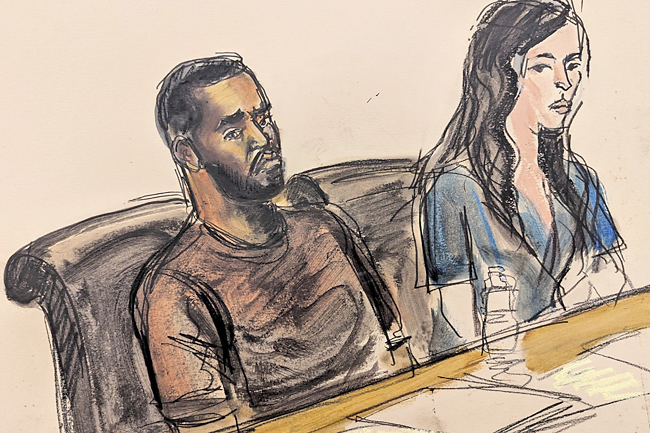NEW YORK (AP) – As they unsuccessfully fought to keep Sean “Diddy” Combs out of jail after his sex trafficking arrest, the music mogul’s lawyers highlighted a litany of horrors at the Brooklyn federal lockup where he was headed: horrific conditions, rampant violence and multiple deaths.
Combs, 54, was sent to the Metropolitan Detention Center (MDC) in Brooklyn last Tuesday – a place that’s been described as “hell on earth” and an “ongoing tragedy” – after pleading not guilty in a case that accuses him of physically and sexually abusing women for more than a decade.
The facility, the only federal jail in New York City, has been plagued by problems since it opened in the 1990s. In recent years, its conditions have been so stark that some judges have refused to send people there. It has also been home to a number of high-profile inmates, including R Kelly, Ghislaine Maxwell and cryptocurrency fraudster Sam Bankman-Fried.
In a statement, the federal Bureau of Prisons said: “We also take seriously addressing the staffing and other challenges at MDC Brooklyn.” An agency team is working to fix problems, including by adding permanent correctional and medical staff, remedying more than 700 backlogged maintenance requests and answering judges’ concerns.
A judge last Wednesday denied a request by Combs’ lawyers to let him await trial under house arrest at his USD48 million mansion on an island in Miami Beach, Florida.
Here are some important things to know about the jail:




WHAT IS THE METROPOLITAN DETENTION CENTER?
The Bureau of Prisons opened the facility, known as MDC Brooklyn, as a jail in the early 1990s.
It’s used mainly for post-arrest detention for people awaiting trial in federal courts in Manhattan or Brooklyn. Other inmates are there to serve short sentences following convictions.
The facility, in an industrial area on the Brooklyn waterfront, has about 1,200 detainees, down from more than 1,600 in January. It has outdoor recreation facilities, a medical unit with examination rooms and a dental suite. It has a separate wing for educational programmes and the jail’s library.
The Bureau of Prisons closed its crumbling Metropolitan Correctional Center in Manhattan in 2021, leaving MDC Brooklyn as its only facility in the nation’s largest city.
WHAT ARE SOME PROBLEMS WITH MDC BROOKLYN?
Detainees have long complained about rampant violence, dreadful conditions, severe staffing shortages and the widespread smuggling of drugs and other contraband, some of it facilitated by employees. At the same time, they say they’ve been subject to frequent lockdowns and have been barred from leaving their cells for visits, calls, showers or exercise.
In June, Uriel Whyte, 37, was stabbed to death at the jail. A month later, Edwin Cordero, 36, died after he was hurt in a brawl. At least four people detained at the jail have died by suicide in the last three years.
Cordero’s lawyer, Andrew Dalack, told The New York Times his client was just the victim of “an overcrowded, understaffed and neglected federal jail that is hell on earth”.
At least six MDC Brooklyn staff members have been charged with crimes in the last five years. Some were accused of accepting bribes or providing contraband such as drugs, cigarettes, and cellphones, according to an Associated Press (AP) analysis of agency-related arrests.
MDC Brooklyn has also come under fire for its response to debilitating infrastructure breakdowns and the COVID-19 pandemic. In 2019, a week-long power failure sparked unrest among shivering inmates and drew concerns from federal watchdogs. In March 2020, the jail had the first federal inmate to test positive for COVID-19.
As of last November, according to court filings, MDC Brooklyn was operating at about 55 per cent of full staffing, which was taxing to employees and added to its security woes.
WHAT IS BEING DONE ABOUT THESE PROBLEMS?
Judges and advocates have taken notice, excoriating the Bureau of Prisons for “dangerous, barbaric conditions” and pressing the agency to make improvements. Some judges have moved away from sending defendants to MDC Brooklyn or have given reduced sentences because of the conditions there.
In January, United States (US) District Judge Furman took the rare step of allowing Gustavo Chavez, 70, to remain free on bail after his conviction for drug crimes rather than locking him up at the Brooklyn jail to await sentencing.
“Prosecutors no longer even put up a fight, let alone dispute that the state of affairs is unacceptable,” Furman wrote.
In August, US District Judge Gary Brown said he would vacate a 75-year-old defendant’s nine-month sentence for tax fraud and place him on home confinement if the Bureau of Prisons sent him to MDC Brooklyn.
In response, the Bureau of Prisons said it had “temporarily paused” sending any defendants convicted of crimes to the jail to serve their sentences. In a statement last Tuesday, the agency said 43 people were currently serving sentences in a minimum-security unit at the jail.


